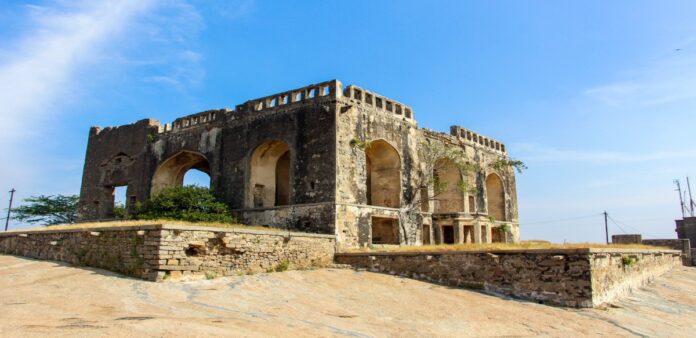Bhuvanagiri Fort, also known as Bhongir Fort, holds a fascinating history that spans several centuries and encompasses the reigns of multiple dynasties. This imposing fortification, situated in the Nalgonda district of Telangana, India, stands as a testament to the region’s rich cultural heritage. Let’s delve into the captivating Bhuvanagiri Fort history
Chalukya Dynasty: The origins of the Bhuvanagiri Fort can be traced back to the 10th century when it was built by the Chalukya dynasty. The fort served as a strategic stronghold for defense purposes and stood as a symbol of the Chalukya ruler’s power and authority.
Kakatiya Dynasty: During the 12th and 13th centuries, the Kakatiya Dynasty gained control of Bhuvanagiri Fort and played a significant role in shaping its architectural grandeur. The Kakatiya rulers expanded the fort’s boundaries, fortified its defenses, and transformed it into an impregnable bastion.
Delhi Sultanate: In the 14th century, the Delhi Sultanate, under the leadership of Alauddin Bahman Shah, captured Bhuvanagiri Fort. This marked a significant turning point in the fort’s history as it became a crucial military outpost for the Bahmani Sultanate, which ruled over the region.
Qutb Shahi Dynasty: With the decline of the Bahmani Sultanate, the Qutb Shahi dynasty established their rule in the Deccan region. Bhuvanagiri Fort came under their dominion and underwent further fortification and expansion. The Qutb Shahi rulers recognized the strategic importance of the fort and utilized it as a defensive stronghold.
Mughal Empire: In the late 17th century, the Mughal Empire, led by Emperor Aurangzeb, annexed the Golconda Sultanate, which included Bhuvanagiri Fort. The fort continued to play a crucial role in the Mughal military strategy in the region and witnessed several battles during this period.
Asaf Jahi Dynasty (Nizams of Hyderabad): Following the decline of the Mughal Empire, the Nizams of Hyderabad, belonging to the Asaf Jahi dynasty, emerged as powerful rulers in the Deccan. Bhuvanagiri Fort became an integral part of their defense infrastructure and was utilized as a military outpost.
Throughout its history, Bhuvanagiri Fort has witnessed numerous conflicts, changes in power, and cultural influences. The fort’s strategic location on a hilltop provided its occupants with a commanding view of the surrounding region, making it an ideal stronghold for defense.
Unknown Facts About Bhuvanagiri Fort
Here are some of the Bhuvanagiri Fort unknown facts
- Ingenious Water Supply System: Bhuvanagiri Fort had an ingenious water supply system that involved a network of wells and underground pipelines. These pipelines would channel water from the surrounding areas and supply it to the fort, ensuring a reliable water source for the inhabitants.
- Hidden Escape Routes: The fort had several hidden escape routes and secret passages, which were cleverly designed to allow the defenders to escape or launch surprise attacks on the enemy. These secret passages were strategically located throughout the fort, providing a tactical advantage during times of conflict.
- Impenetrable Defense Mechanisms: To reinforce its defenses, Bhuvanagiri Fort had a unique feature called the “Mati-ki-Burj” or “Tower of Earth.” This tower was constructed using layers of compacted earth and lime, making it resistant to cannon attacks and rendering it virtually impenetrable.
- Astronomical Significance: Bhuvanagiri Fort’s location and architecture hold astronomical significance. The fort is aligned in such a way that the sunrise and sunset during the equinoxes can be observed from specific vantage points within the fort, indicating the architectural precision of its builders.
- Influence of Persian Architecture: While the fort predominantly exhibits Indian architectural elements, there are also subtle influences of Persian architecture. This amalgamation of architectural styles reflects the cultural exchange and influences prevalent during the fort’s construction and subsequent reigns.
- Rock-Cut Steps: The ascent to the fort involved climbing a series of rock-cut steps carved into the natural rock formation. These steps were meticulously carved and provided a secure pathway for the fort’s defenders and visitors, further enhancing the fort’s defensive capabilities.
- Echo Effect: One intriguing feature of Bhuvanagiri Fort is its echo effect. When a sound is made at a particular point within the fort, it reverberates and echoes throughout the premises. This natural acoustic phenomenon adds an enchanting aspect to the fort’s ambiance.
- Geological Marvel: The hill on which Bhuvanagiri Fort stands is composed of a unique geological formation known as the Bhongir Gneiss. This type of rock formation is known for its durability and resistance to weathering, contributing to the fort’s structural strength and longevity.
- Film Location: Bhuvanagiri Fort has served as a picturesque backdrop for several Indian movies. The fort’s architectural grandeur and scenic surroundings have made it a popular choice for filmmakers looking to capture the essence of history and drama on screen.
Exploring the lesser-known facts about Bhuvanagiri Fort adds a sense of intrigue and wonder to this ancient stronghold. These hidden aspects provide a deeper understanding of the fort’s historical significance and its enduring allure as a cultural and architectural marvel.
Bhuvanagiri Fort Timings: 10:00 am to 06:00 pm
How to Reach Bhuvanagiri Fort
Reaching Bhuvanagiri Fort is relatively easy as it is well-connected by roadways and lies near major cities in Telangana. Here are the recommended routes to reach Bhuvanagiri Fort and you can easily travel via buses run by TSRTC to from your place
From Hyderabad: Bhuvanagiri Fort is approximately 50 kilometers away from Hyderabad. You can take a private car or a cab and drive via the NH163 or NH163A route, which takes around 1-2 hours, depending on traffic conditions.
From Nalgonda: Nalgonda, the district headquarters, is around 40 kilometers away from Bhuvanagiri Fort. You can hire a taxi or take a state-run bus from Nalgonda to reach the fort. Also, the distance from Bhuvanagiri Fort to Yadadri temple is around 17 km.
From Warangal: If you are traveling from Warangal, the fort is approximately 100 kilometers away. You can take the NH163 route or opt for a state-run bus to reach Bhuvanagiri Fort.
Local transportation options such as taxis, auto-rickshaws, and buses are available near the fort to explore the surrounding areas.
It is advisable to check the current road conditions, traffic, and weather conditions before planning your visit. Additionally, it is recommended to carry sufficient water, snacks, and sun protection, as Bhuvanagiri Fort can be physically demanding due to its location atop a hill.
Today, the Bhuvanagiri Fort story stands as a remarkable architectural marvel, bearing testament to the craftsmanship and resilience of the dynasties that once ruled the region. Its rich historical significance, coupled with its panoramic views and intriguing legends, make it a popular destination for tourists and history enthusiasts alike. The fort’s history serves as a gateway to understanding the region’s past and the various dynasties that have left their mark on its cultural landscape.





